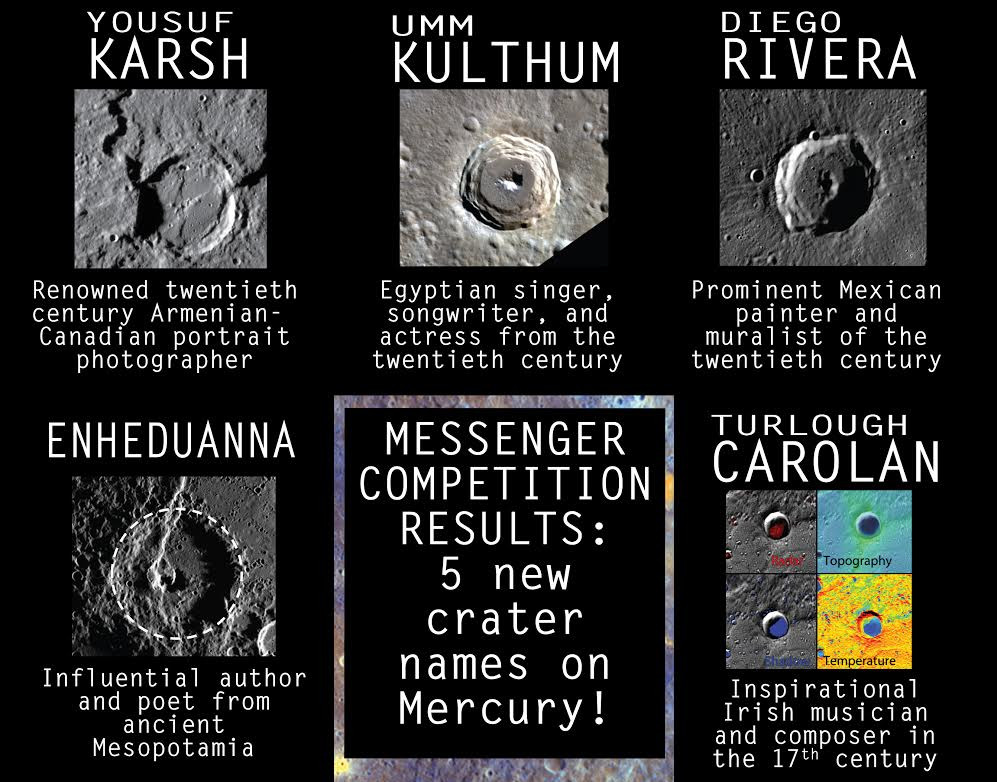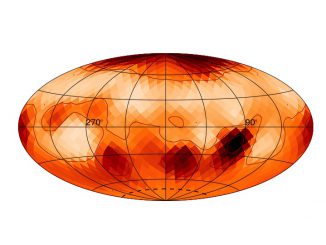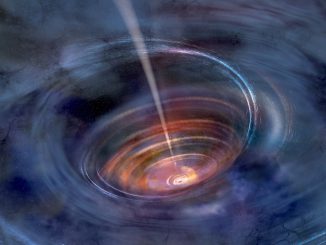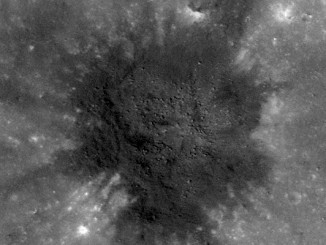The MESSENGER Education and Public Outreach (EPO) Team, coordinated through Carnegie Science, announces the winning names from its competition to name five impact craters on Mercury. The contest submissions had to be submitted by January 15th, 2015, and the International Astronomical Union (IAU) — the governing body of planetary and satellite nomenclature since 1919 — made the selections from a semi-final submission of 17 artists’ names. The newly selected crater names are Carolan, Enheduanna, Karsh, Kulthum, and Rivera.
Under IAU rules, all new craters on Mercury must be named after an artist, composer, or writer who was famous for more than 50 years and has been dead for more than three years. Turlough O’Carolan (Carolan) was an Irish composer during the late 1600s and early 1700s. Enheduanna, an Akkadian princess who lived in the Sumerian city of Ur in ancient Mesopotamia (today’s Iraq and Kuwait), is regarded by many scholars as possibly the earliest known author and poet. Yousuf Karsh was an Armenian/Canadian and one of the greatest portrait photographers of the twentieth century. Umm Kulthum was an Egyptian singer, songwriter, and film actress of the 1920s to the 1970s; and Diego Rivera was a prominent Mexican painter and muralist from the 1920s to the 50s.
The winners come from many different countries. Carolan was suggested by Fergal Donnelly (Belgium); Joseph Brusseau (USA); and Deane Morrison (USA). Enheduanna was submitted by Gagan Toor (India). Karsh was submitted by Elizabeth Freeman Rosenzweig (USA). Kulthum was suggested by Malouk Ba-Isa (Saudi Arabia); Riana Rakotoarimanan (Switzerland); Yehya Hassouna (USA); David Suttles (USA); Thorayya Said Giovanelli (USA); and Matt Giovanelli (USA). Rivera was suggested by Ricardo Martinez (Mexico); Rebecca Hare (USA); Arturo Gutierrez (Mexico); and José Martinez (USA).
Julie Edmonds, the EPO team leader at the Carnegie Institution for Science, remarked, “The IAU working group that chose the names was very happy with the submissions. In all we had 3,600 contest entries, a resounding success for the excitement that the MESSENGER mission to Mercury has generated.”
NASA’s MESSENGER spacecraft has been in orbit about Mercury since March 2011 and, because it has run out of propellant, is due to finally impact the planet today (30th April, ~19:26 UTC). The first ever spacecraft to orbit the innermost planet, the MESSENGER spacecraft has far surpassed expectations in the duration of the mission and in the quantity and quality of data returned. The original goal of the craft was to take 2,500 images of the planet, but is has returned more than 270,000.

Six MESSENGER facts courtesy of Jim Raines, University of Michigan research scientist and MESSENGER team member:
- Meteors with the same mass as MESSENGER (513 kg) slam into Mercury about every month or two, and typically with 10 times the speed and 100 times the energy. The planet doesn’t have a thick atmosphere that would slow down objects headed for the surface.
- The 1,131-pound (514-kg) spacecraft will hit with the energy of about a ton of TNT, or the force of a car travelling at about 2,000 miles per hour (900 metres per second).
- At almost 9,000 miles per hour (4 kilometres per second), the craft will be travelling three times faster than a speeding bullet and nearly twelve times the speed of sound.
- On MESSENGER’s last orbit, it will pass just 900 to 1,800 feet (275 to 550 metres) over the planet’s surface. We have buildings that tall on Earth.
- The crater the craft will leave near Mercury’s north pole is predicted to be about 52 feet (16 metres) wide. That’s the width of an NBA basketball court.
- Nearly 55 percent of MESSENGER’s weight at launch was fuel — which is about to run out.




